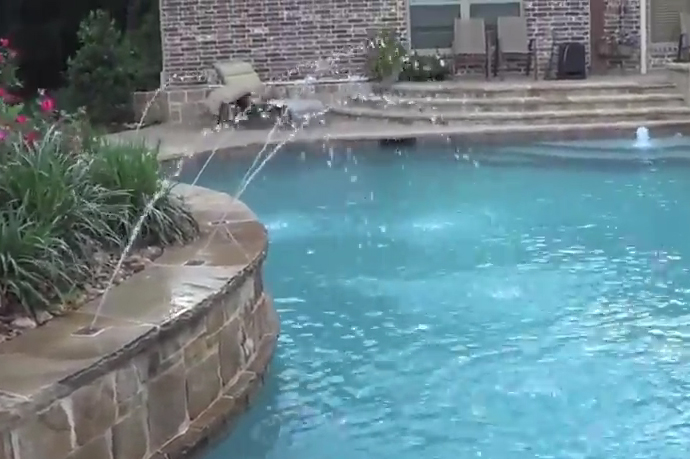#14: Cannon Jets

These days, it seems like just about every homeowner wants to get something special with their pools and spas. More often than not, that means some form of water in transit, whether it’s a cool spillway, a vanishing edge, a bubbler on a thermal shelf – or, as in the case highlighted here, some sort of jet that will send an arc of water into the pool.
There are so many possibilities with jets that you (and your clients) can get lost in them. You can hide their sources back in a planter, put them on the top of a wall or stick them on the vertical face of a raised bond beam or nearby wall. I’ve even seen pools where the jets are placed inside the pool and shoot to locations outside the water’s edge. The only limit is the ability to imagine what can be done.
But as I indicate in the video linked below, these jet arrays come with two key problems: First, the streams are easily influenced by wind; second, they can be noisy (which may be desirable) and monotonous (which usually isn’t).
Wind can be a tough factor. We addressed it with this pool by individually valving them so they can be adjusted to keep the water from flying where it’s not wanted. (They might also have been valved as a group, but the individual approach gives the homeowner much more flexibility in making the necessary adjustments.) Another option would be controlling the jets with some form of anemometer – that is, a wind gauge – that could reduce or cut off the flow when the wind hits a pre-set level.
As for the noise, this is another reason we went for individual valving: If the water hits the surface from a variety of heights and angles, the sound becomes less monotonous (although not entirely so). It also lets our clients shut down jets near the outdoor dining area to make conversation easier at the table, for example, or close by bedroom windows; whatever the specifics, this leaves the less aurally intrusive jets to decorate the scene.
Some people aren’t bothered by the noise, but I find that it’s an impediment to conversation near the pool and gets on my nerves. This is why I’m happy there are so many possibilities with jets: I can usually find a solution that makes everyone happy!
To see (and hear) this jet array in action, click here.
Mike Farley is a landscape designer with more than 25 years of experience and is currently a designer/project manager for Claffey Pools in Southlake, Texas. A certified member of Genesis 3’s Society of Watershape Designers, he holds a degree in landscape architecture from Texas Tech University and has worked as a watershaper in both California and Texas.
Normal
0
false
false
false
EN-US
X-NONE
X-NONE
MicrosoftInternetExplorer4
These days, it seems like just about every homeowner wants to get something special with their pools and spas. More often than not, that means some form of water in transit, whether it’s a cool spillway, a vanishing edge, a bubbler on a thermal shelf – or, as in the case highlighted here, some sort of jet that will send an arc of water into the pool.
There are so many possibilities with jets that you (and your clients) can get lost in them. You can hide their sources back in a planter, put them on the top of a wall or stick them on the vertical face of a raised bond beam or nearby wall. I’ve even seen pools where the jets are placed inside the pool and shoot to locations outside the water’s edge. The only limit is the ability to imagine what can be done.
But as I indicate in the video linked below, these jet arrays come with two key problems: First, the streams are easily influenced by wind; second, they can be noisy (which may be desirable) and monotonous (which usually isn’t).
Wind can be a tough factor. We addressed it with this pool by individually valving them so they can be adjusted to keep the water from flying where it’s not wanted. (They might also have been valved as a group, but the individual approach gives the homeowner much more flexibility in making the necessary adjustments.) Another option would be controlling the jets with some form of anemometer – that is, a wind gauge – that could reduce or cut off the flow when the wind hits a pre-set level.
As for the noise, this is another reason we went for individual valving: If the water hits the surface from a variety of heights and angles, the sound becomes less monotonous (although not entirely so). It also lets our clients shut down jets near the outdoor dining area to make conversation easier at the table, for example, or close by bedroom windows; whatever the specifics, this leaves the less aurally intrusive jets to decorate the scene.
Some people aren’t bothered by the noise, but I find that it’s an impediment to conversation near the pool and gets on my nerves. This is why I’m happy there are so many possibilities with jets: I can usually find a solution that makes everyone happy!
To see (and hear) this jet array in action, click here.
https://www.youtube.com/watch?v=r630-f5SMrY
Mike Farley is a landscape designer with more than 25 years of experience and is currently a designer/project manager for Claffey Pools in Southlake, Texas. A certified member of Genesis 3’s Society of Watershape Designers, he holds a degree in landscape architecture from Texas Tech University and has worked as a watershaper in both California and Texas.










